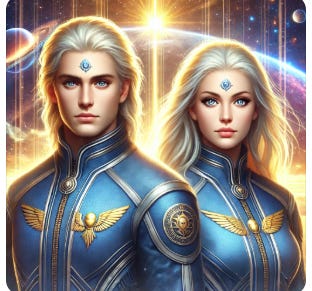Unveiling the Pleiadian Connection
Humanity’s Cosmic Roots, Ancient Myths, and the Path to Unity
Anyone who is a Pleiadian starseed may resonate with chapter six of the book titled, The Prism of Lyra by Lyssa Royal-Holt.
The author revisits the story of the Lyrans, a civilization that chose to move to another part of the galaxy to escape the turmoil of a masculine-dominant society and integrate their beliefs in peace. Seeking refuge from their planet’s conflicts, they eventually made Earth their new home.
Initially, the Lyrans struggled to adapt to Earth’s physical and electromagnetic conditions. To survive, they modified their DNA by blending it with that of early primates as well as inserting their own genetics into these primates as well.
This raises an interesting question: Could this have been part of the Annunaki or Garden of Eden narrative, or is it a story which parallels the broader history of Earth?
Over time, these Earth-Lyrans (a mix of primate and Lyran genetics) discovered that the very conflicts from which they fled from–started to re-emerge on Earth. Determined to create a better life for themselves, they ventured out once more. They later settled in a cluster of young blue stars known as the Pleiades. They had envisioned a society rooted in balance, sovereignty, harmony, and unconditional love. However, creating a utopian society was no easy feat. It took generations of effort, philosophical growth, and technological advancement, as well as navigating internal and external conflicts. Despite these challenges, they eventually built a civilization they had dreamed about for millennia.
A fascinating detail worth noting from the book: as we can only see seven stars in the Pleiades from Earth, this cluster is actually made up of hundreds of stars, not visible to the naked eye.
The early Pleiadians thrived in a "positivity bubble," - devoid of conflict, which left them feeling unfulfilled. Without purpose, struggles to overcome, or lessons to learn, they felt disconnected from the creative energy that wanted to flow through them. Within this “bubble”, they became isolated to the point they were unaware of a conflict brewing among their distant relatives, the Orions—both civilizations, which share roots of the Lyran lineage.
When news of the Orion struggle reached the Pleiadians, their innate desire to be in service was reignited. Their efforts to assist took on various forms: some chose to incarnate with a blend of light and shadow to better understand the complexities of the Orion conflict, while others joined the Black League (the resistance). Both groups wrestled with external adversaries including the shadows within.
Tragically, the conflicts escalated, leading to the destruction of one of the Pleiadians' home planets. This loss has become a haunting reminder of the turmoil and division they endured.
The Pleiadians had to face a choice: return to the Pleiades for healing or continue battling in the Orion wars. They chose to retreat home, using the time to reflect and heal. As time passed, their fear of further entanglement left them stagnant. The Lyrans and Sirians approached them with an ambitious proposal: the Inception Project. This collaborative effort was aimed to develop humanity by integrating Pleiadian DNA into Earth’s evolving species.
This wasn’t a single act, but a prolonged process of DNA adjustments and interactions designed to explore and understand humanity's negative aspects.
Again, could this project be within alignment of the Garden of Eden, Adam and Eve, or Annunaki stories?
The Pleiadians were the first benevolent race to engage in direct physical contact with humans. Over thousands of years, they have guided and observed humanity, while humans document their interactions on cave walls and ancient artifacts. Humans often perceived them as gods or divine beings, as seen in depictions of blue-skinned deities, animal-human hybrids, and humanoid figures with interesting traits such as pointed tip ears or elongated heads.
However, even the Pleiadians were not immune to the temptations of power. As humans worshipped them, they began to wield influence through fear tactics, mirroring ancient myths of jealous gods. The negative Sirians also played a role in this era of manipulation, contributing to a competitive “power grab” among extraterrestrial factions. The Pleiadians, grappling with their shadow selves, manifested these darker tendencies as a reflection of their inner struggles.
The author notes that extraterrestrial contact has occurred in cycles, with heightened activity in the 1930s, 1950s, 1970s, and beyond. A Swiss contactee, Billy Meier, documented extensive interactions with a Pleiadian cosmonaut named Semjase, including time travel and physical evidence like rare metal samples. While many dismissed his accounts as hoaxes, the underlying messages—emphasizing unity, environmental stewardship, and mutual care—remain profound and largely ignored by humanity.
Between 1980 and 1982, the collective consciousness shifted toward greater accountability, which signaled a growing awareness of humanity’s role in shaping its destiny. The Pleiadians have acknowledged their imperfections and past mistakes, admitting that their wounds and egoic actions have had consequences for humanity. Yet, they remind us that the answers we seek are not in them, but within ourselves.
As humanity evolves, the Pleiadians continue to observe, ready to assist but leaving the ultimate responsibility to us. Open contact, they suggest, will only be possible when humanity learns to balance self-interest with service to others. The wall of separation must dissolve for this connection to flourish.
So, the question remains: Will we rise to the call of unity and self-awareness, or will we choose skepticism and ego? Perhaps it is not the extraterrestrial beings we must understand, but the reflections of ourselves they mirror back to us. Are we ready to face that reflection and transcend it?
I have faith in humanity. We will rise to the occasion and embrace one another with open arms soon. It is not a matter of “if”, but “when”.



